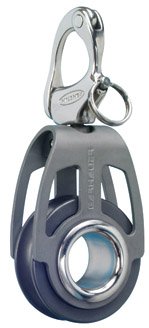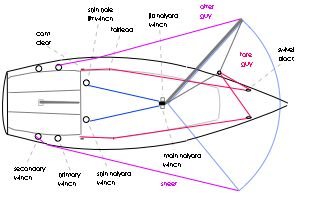I was skimming through craigslist (dangerous, dangerous) and came across a decent symmetrical spinnaker that was the right size for my boat, and the price was right. In the distant past, the boat was raced extensively and came with all sorts of hardware remnants and a spinnaker pole. So now I'm trying to decipher how it was once rigged, how it should be rigged, and what more parts I need to buy (or remove.)
The attached diagram shows the approximate location of relevant hardware and my current interpretation. The boat did not come with a reaching strut, but there are brackets on the mast for one. (I had planned to order a new asymmetric next year, for reaching situations. But conditions are fluid.)
First question: Part A. I see some rigging diagrams show separate lines to each clew for after-guys and sheets. Others show just one. Why would I want to complicate things in this way?
Part B. Say I used the genoa sheets as after-guys, running them through their regular blocks on the genoa track (runs along the rail) to the primary winches. Would this eliminate the need for a reaching strut?
Second question: All of the diagrams I've seen show a single swivel block for the foreguy near the bow. Mine has one on each side, slightly aft of the bow, with a fairlead and a cam-cleat attached to the side of the cabin on each side. A faded label by each cleat says "foreguy." (I previously used one of them to run a down-f**ker to the jib, before I got roller-furling.) Why would they complicate things in this way? Does this mean that there is a "lazy foreguy?" There was apparently no provision for using winches on the foreguys previously. How much force does it take?
Man, this seems like a lot of strings dangling around. The next problem would be how on earth to gybe all that stuff. Obviously I want to keep the rigging as simple as possible.

The attached diagram shows the approximate location of relevant hardware and my current interpretation. The boat did not come with a reaching strut, but there are brackets on the mast for one. (I had planned to order a new asymmetric next year, for reaching situations. But conditions are fluid.)
First question: Part A. I see some rigging diagrams show separate lines to each clew for after-guys and sheets. Others show just one. Why would I want to complicate things in this way?
Part B. Say I used the genoa sheets as after-guys, running them through their regular blocks on the genoa track (runs along the rail) to the primary winches. Would this eliminate the need for a reaching strut?
Second question: All of the diagrams I've seen show a single swivel block for the foreguy near the bow. Mine has one on each side, slightly aft of the bow, with a fairlead and a cam-cleat attached to the side of the cabin on each side. A faded label by each cleat says "foreguy." (I previously used one of them to run a down-f**ker to the jib, before I got roller-furling.) Why would they complicate things in this way? Does this mean that there is a "lazy foreguy?" There was apparently no provision for using winches on the foreguys previously. How much force does it take?
Man, this seems like a lot of strings dangling around. The next problem would be how on earth to gybe all that stuff. Obviously I want to keep the rigging as simple as possible.

Last edited:



